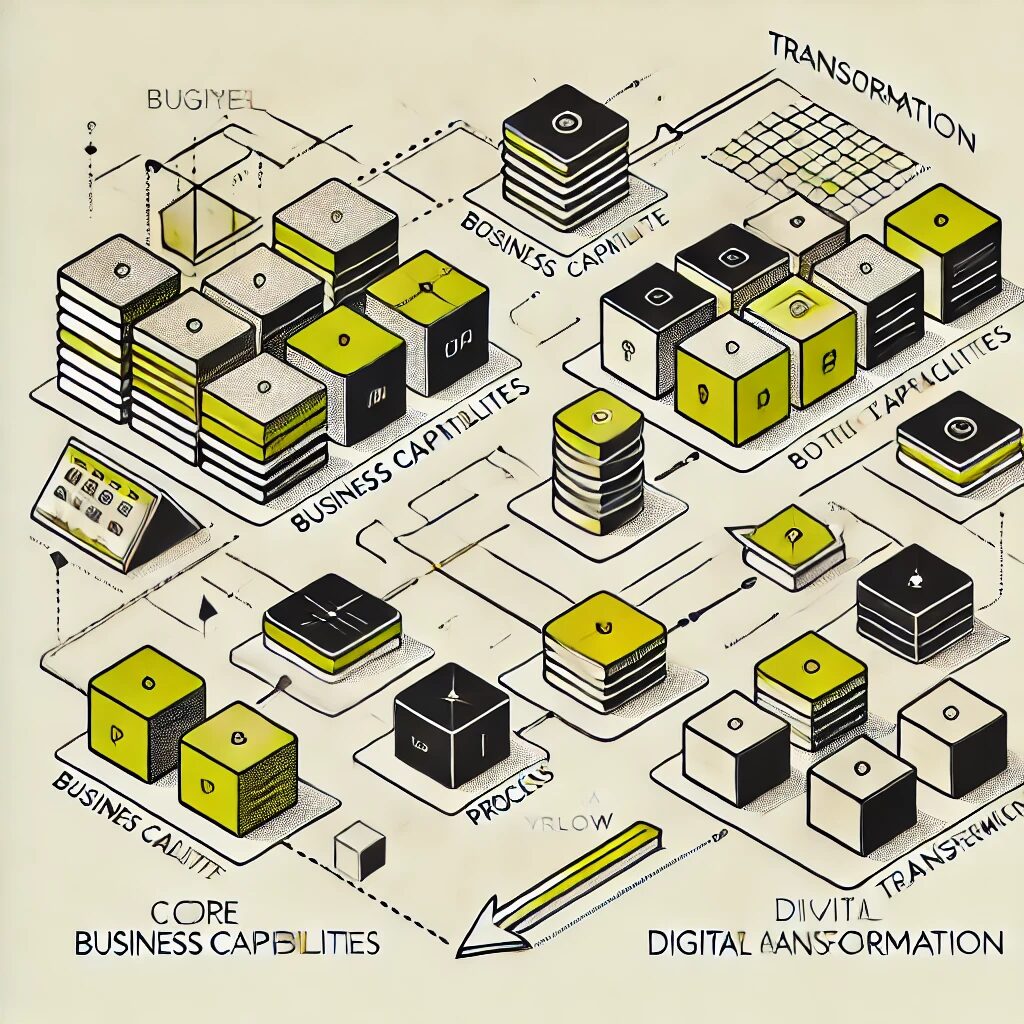
Business Architecture as the Transformation Engine for Professional Services. From Strategy to Reality: Where Vision Meets Execution.
In today’s hypercompetitive professional services landscape, the gap between strategic intent and operational reality has never been more challenging to bridge. As client expectations evolve and digital disruption accelerates, professional services firms find themselves at a critical crossroads: transform or be left behind.
Business Architecture emerges as the essential framework that translates strategic aspirations into actionable blueprints for change. It provides the critical connective tissue between vision and execution, enabling professional services firms to navigate complexity and drive meaningful transformation across the enterprise.
1: The Transformation Imperative
Professional services firms face unprecedented pressure to evolve their business models while maintaining service excellence. Business Architecture provides the structured approach needed to manage this complex balancing act.
- Market Realities: The professional services sector faces margin compression, with 68% of firms reporting increased competition driving down profitability margins by an average of 14% over the past five years.
- Client Expectations: Today’s clients demand tailored solutions, transparent value delivery, and technology-enabled experiences that traditional service models struggle to deliver efficiently.
- Operational Complexity: As firms expand service portfolios and geographic reach, organizational silos create friction that impedes agility and responsiveness to market changes.
- Talent Evolution: The changing nature of professional work requires new capabilities, delivery models, and workforce dynamics that many firms aren’t structured to support.
2: Business Architecture Defined
Business Architecture provides the comprehensive blueprint that aligns organizational capabilities with strategic objectives, creating the foundation for successful transformation initiatives.
- Strategic Lens: Business Architecture translates abstract strategic goals into concrete business designs that define how the organization will create, deliver, and capture value.
- Holistic Framework: It encompasses capabilities, processes, information, organizational structures, and technology in an integrated view that transcends departmental boundaries.
- Decision Enabler: Well-crafted Business Architecture enables more informed decision-making by providing visibility into interdependencies and impact analysis for potential changes.
- Transformation Accelerator: By creating a shared organizational language and reference model, Business Architecture reduces friction in change initiatives and accelerates implementation timelines.
3: The Architecture Maturity Journey
Developing effective Business Architecture capabilities is an evolutionary process that delivers increasing value as it matures within the professional services organization.
- Foundation Building: Initial efforts focus on documenting core capabilities, establishing governance, and creating baseline models that provide organizational clarity.
- Functional Integration: As maturity increases, Business Architecture connects departmental perspectives into a cohesive view that spans client acquisition, service delivery, and support functions.
- Strategic Alignment: Mature Business Architecture becomes the mechanism that ensures investments and initiatives directly support strategic objectives through explicit traceability.
- Transformation Engine: At its highest maturity, Business Architecture drives innovation and transformation by identifying capability gaps and orchestrating change across people, process, and technology dimensions.
DID YOU KNOW?
- A recent Forrester study revealed that 78% of professional services executives identified Business Architecture as a critical enabler for successful digital transformation initiatives.
4: Capability Mapping for Service Excellence
Capability mapping creates a powerful lens through which professional services firms can align resources, prioritize investments, and drive transformation initiatives.
- Service Delivery Core: Capability models identify and prioritize the essential functions that drive differentiated client experiences and operational excellence in service delivery.
- Investment Prioritization: Heat mapping capabilities against strategic importance and performance gaps directs transformation resources to the areas of highest potential impact.
- Sourcing Strategy: Capability analysis enables smarter decisions about which functions to develop internally, which to acquire through partnerships, and which to outsource.
- Digital Opportunity Identification: Mapping capabilities reveals high-value automation and augmentation opportunities that can transform service delivery efficiency and effectiveness.
5: Process Architecture for Operational Excellence
Process architecture provides the operational blueprint that ensures consistent, efficient, and client-centric service delivery across the professional services organization.
- End-to-End Visibility: Process mapping creates transparency across departmental boundaries, revealing inefficiencies and disconnects in the client service journey.
- Variability Management: Standardized process models establish the foundation for optimizing the balance between necessary customization and inefficient variation in service delivery.
- Experience Design: Client-centric process architecture aligns internal operations with client expectations at each stage of the engagement lifecycle.
- Continuous Improvement: Process architecture establishes the baseline for ongoing optimization, creating the foundation for sustainable operational excellence.
6: Information Architecture for Knowledge Advantage
In knowledge-intensive professional services, information architecture emerges as a critical competitive differentiator that unlocks expertise at scale.
- Knowledge Mobilization: Effective information architecture enables firms to capture, organize, and deploy their intellectual capital across client engagements.
- Decision Support: Well-designed information models ensure that professionals have access to the right information at the right time to make optimal client service decisions.
- Analytics Foundation: Robust information architecture creates the foundation for advanced analytics that reveal insights about client needs, service performance, and market opportunities.
- Compliance Framework: Information architecture establishes the controls necessary to maintain confidentiality, regulatory compliance, and appropriate information governance.
7: Organizational Architecture for Agile Talent
The right organizational design enables professional services firms to deploy specialized expertise while maintaining operational efficiency and service consistency.
- Structure Optimization: Organizational architecture determines how to structure teams for the optimal balance of specialization and collaboration in service delivery.
- Governance Models: Clear governance frameworks establish decision rights that enable appropriate autonomy while maintaining necessary controls and alignment.
- Role Definition: Well-crafted organizational architecture creates role clarity that reduces friction and enables professionals to work at the top of their capabilities.
- Matrix Management: Modern professional services require organizational designs that balance practice specialization with client-centric delivery teams.
- Talent Development: Organizational architecture creates the career pathways and skill development frameworks that attract and retain top professional talent.
8: Technology Architecture for Digital Enablement
Technology architecture ensures that digital investments directly enable and enhance the firm’s core capabilities and client value proposition.
- Platform Strategy: A cohesive technology architecture establishes the digital foundation that supports scalable service delivery and operational efficiency.
- Integration Framework: Well-designed technology connections eliminate data silos and enable seamless information flow across the client journey.
- Automation Roadmap: Technology architecture identifies high-value automation opportunities that free professionals from routine tasks to focus on higher-value client work.
- Innovation Pipeline: A forward-looking technology architecture establishes the capabilities needed to incubate and scale new technology-enabled service offerings.
DID YOU KNOW?
- McKinsey research found that professional services firms with strong Business Architecture capabilities achieved 32% higher revenue growth over a five-year period compared to industry peers.
9: Architecture Governance for Sustainable Change
Effective governance ensures that Business Architecture remains relevant, utilized, and aligned with organizational objectives over time.
- Decision Framework: Architecture governance establishes clear processes and authorities for making decisions about Business Architecture changes and exceptions.
- Quality Controls: Governance mechanisms ensure that architecture artifacts maintain consistent quality and adhere to established standards.
- Change Management: Governance processes manage the evolution of the Business Architecture to reflect changing strategic priorities and market conditions.
- Stakeholder Engagement: Effective governance creates the feedback loops and engagement models that maintain executive support and practitioner adoption.
10: Client Experience Architecture
Business Architecture enables professional services firms to design and deliver differentiated client experiences that drive loyalty and growth.
- Journey Mapping: Experience architecture documents the end-to-end client journey, identifying moments that matter and opportunities to differentiate.
- Service Blueprinting: Detailed service designs align front-stage client interactions with the backstage operations that deliver on promises.
- Digital Touchpoints: Experience architecture optimizes the integration of digital and human interactions throughout the client relationship lifecycle.
- Measurement Framework: Well-designed experience architecture establishes the metrics and feedback mechanisms that drive continuous improvement in client satisfaction.
11: Implementation Roadmapping
Business Architecture translates transformation vision into actionable implementation plans that deliver incremental value while building toward strategic goals.
- Initiative Sequencing: Architecture-driven roadmaps establish the optimal sequence of change initiatives based on dependencies, constraints, and value realization.
- Capability Incrementalism: Well-crafted roadmaps build capabilities progressively, ensuring that each phase delivers tangible benefits while setting the foundation for future advances.
- Resource Optimization: Implementation roadmaps align transformation activities with resource availability to prevent change fatigue and execution bottlenecks.
- Risk Management: Architecture-based planning identifies and mitigates transformation risks through appropriate sequencing and change management approaches.
12: Measuring Architecture Impact
Business Architecture must demonstrate tangible value to maintain organizational support and investment over time.
- Performance Metrics: Well-designed measurement frameworks track how Business Architecture directly contributes to operational efficiency, service quality, and financial outcomes.
- Adoption Indicators: Usage metrics reveal the extent to which Business Architecture artifacts are actively informing decisions across the organization.
- Capability Evolution: Maturity assessments track the progressive development of architectural capabilities and their impact on organizational performance.
- Value Realization: Explicit tracing of architecture contributions to strategic initiatives demonstrates the concrete return on architecture investments.
13: The Architect’s Evolving Role
The Business Architect in professional services organizations must evolve from technical specialist to strategic business partner.
- Strategic Advisor: Today’s Business Architect must develop deep business acumen to serve as a trusted advisor on strategic transformation initiatives.
- Cross-Functional Facilitator: Effective architects serve as collaborative bridges between business and technology stakeholders, translating between specialized domains.
- Change Catalyst: The modern Business Architect actively drives change adoption through stakeholder engagement and change management expertise.
- Future State Visionary: Leading architects balance pragmatic current state documentation with inspirational future state designs that motivate transformation.
14: Common Pitfalls and How to Avoid Them
Successfully implementing Business Architecture requires navigating common challenges that undermine value realization.
- Excessive Detail: Avoid the paralysis of perfectionism by focusing on fit-for-purpose models that deliver immediate value while evolving over time.
- Technology Fixation: Overcome the tendency to equate architecture with technology by maintaining persistent focus on business outcomes and capability development.
- Ivory Tower Syndrome: Counter isolation by embedding architects within business teams and establishing regular touchpoints with operational stakeholders.
- Change Resistance: Address organizational inertia through deliberate change management, stakeholder engagement, and demonstrable early wins.
- Scope Creep: Maintain focus by explicitly connecting architecture activities to strategic priorities and establishing clear boundaries for initial efforts.
DID YOU KNOW?
- According to Gartner, organizations with mature Business Architecture practices are 2.7 times more likely to successfully execute major transformation initiatives than those without.
Takeaway
Business Architecture provides the essential framework that enables professional services firms to navigate complexity and drive meaningful transformation. By creating alignment between strategy and execution, Business Architecture ensures that change initiatives deliver tangible business value. The most successful firms leverage Business Architecture not as a documentation exercise, but as a dynamic transformation engine that continually evolves with changing market conditions and strategic priorities.
Next Steps
- Conduct an Architecture Maturity Assessment: Evaluate your current Business Architecture capabilities against industry benchmarks to identify priority improvement areas.
- Develop a Capability Map: Create a baseline capability model that identifies the core functions that drive your firm’s competitive differentiation and operational excellence.
- Align Architecture With Strategy: Explicitly connect your Business Architecture efforts to strategic priorities by mapping how architectural elements support key strategic objectives.
- Establish Governance Mechanisms: Implement lightweight governance processes that maintain architecture quality while enabling appropriate adaptability.
- Build Cross-Functional Teams: Create collaborative teams that bring together business and technology perspectives to develop holistic architectural solutions.


